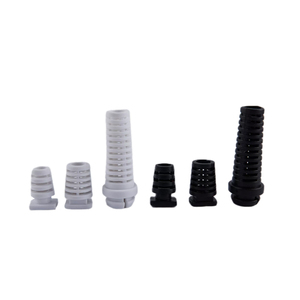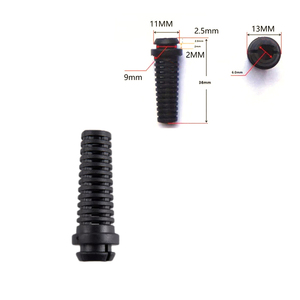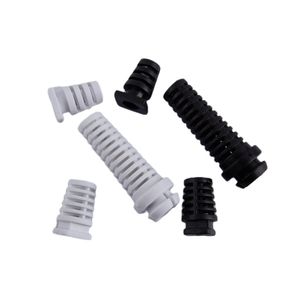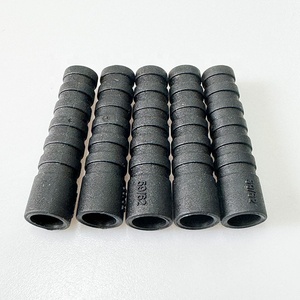
All categories
Featured selections
Trade Assurance
Buyer Central
Help Center
Get the app
Become a supplier

(1665 products available)






































Rubber strain relief comes in different types, suitable for diverse applications and cable configurations. Here’s an overview of the most common ones:
As the name suggests, these strain reliefs are directly molded to the cable jackets. This integration provides a seamless transition between the cable and the connector or housing. The benefit of direct molded strain relief is its robustness. It eliminates any chance of separation under high tension or flexing. Therefore, users find it mainly in heavy-duty industrial and military applications. These environments often expose cables to extreme conditions.
The push-on type offers a quick installation method. This strain relief can be easily snapped or pushed onto cables without the need for adhesives or additional fittings. Many users like this style because of its efficiency, especially in assembly line situations. In these cases, speed of installation is crucial. Hotels and workstations that frequently reorganize or replace equipment use push-on strain reliefs often.
Users fasten the mechanical clamp strain relief with screws or bolts. This makes it a more secure option for high-load applications. This option provides a strong hold on the cable while also being secured to a mounting surface. Its high strength makes it suitable for use in heavy machinery, robotics, and power distribution systems. These all tend to have high cable tension.
TPE strain reliefs combine rubber-like flexibility with plastic's durability. It is lightweight and can be produced in a wider range of hardness levels. This variety allows for customization based on specific needs. TPE strain reliefs are versatile and commonly used in both consumer electronics and industrial devices. This is where a balance of flexibility and durability is necessary.
The split design allows for easier installation and access. This strain relief is especially useful when retrofitting existing systems. One half of the split can be hinged or otherwise designed to quickly snap onto the cable. This design is most useful for maintenance-heavy environments. These include data centers or telecommunications hubs where quick access to cables is essential.
The durability and design of rubber strains are critical factors to consider when selecting the suitable solution for cable management. With several design features, durability ensures that strain relief effectively protects cables in the long term.
Rubber strain relief components commonly use high-quality elastomers like natural rubber, nitrile rubber, and silicone. Each material has distinct advantages. Natural rubber offers superior elasticity and tensile strength. This property ensures that the strain relief can absorb tension and flexing without permanent deformation. Nitrile rubber, on the other hand, is especially resistant to oils, chemicals, and abrasion. These features make it ideal for automotive and industrial settings where exposure to such elements is common.
Meanwhile, silicone rubber can maintain flexibility and durability in extreme temperatures. This makes it suitable for aerospace or high-heat environments. Additionally, silicone can be easily molded into complex shapes. This offers design options that may not be possible with other materials.
Key design features of rubber strain reliefs significantly contribute to their durability. One such feature is the flexibility and Shore hardness equivalent. Shore hardness refers to the resistance of elastomers to permanent indentation. A well-designed strain relief will have the correct Shore hardness. This will ensure it provides enough flexibility without becoming too soft and losing shape.
Furthermore, knurling, ridges, or other surface textures are incorporated into rubber strain reliefs. They improve grip and reduce wear. These surfaces increase the friction between the strain relief and the cable or housing. This helps distribute mechanical stress more evenly across the rubber's surface. In addition, reinforcements like fabric or wire mesh are integrated into some rubber strain relief designs.
This added durability is for high-load applications. These reinforcements help to resist elongation or tearing under extreme conditions. Continuous exposure to UV radiation, ozone, and extreme temperatures will degrade many elastic materials over time. However, certain rubber strain reliefs feature UV-resistant compounds. This protects them in outdoor applications.
Rubber strains withstand various environmental factors, including temperature extremes, UV exposure, and chemical contact. Chemicals like oils, solvents, and acids can rapidly degrade many materials. However, rubber strains, particularly those made from nitrile and TPE, have excellent chemical resistance. They make them ideal for harsh industrial environments.
In outdoor applications, UV exposure is a significant concern. Strain reliefs with UV-resistant materials ensure long-term performance without cracking or losing elasticity. Meanwhile, in aerospace or automotive applications, where cables are exposed to extreme temperatures, silicone rubber strains are favored. They can maintain flexibility and a tight seal in environments of -60 to 250 °C.
Various sectors and applications widely incorporate rubber strain relief. It ensures cable longevity and dependability. Below are the most frequently encountered scenarios:
Rubber strain relief is crucial in industrial settings where cables endure extreme conditions. Large machinery generates vibrations and metal components, which can damage cables. In such cases, strain reliefs absorb this tension and movement, preventing wear and breaking. The maintaining of cable integrity not only increases sustainability but also minimizes unplanned downtimes that are costly. No wonder it is a must-have in factories, especially where machinery is heavy.
In telecommunications data centers, and server rooms, cable management is vital for smooth operations. Split strain relief is often employed in these spaces. This is because it allows for quick cable access without disrupting the entire system. Good strain relief prevents cable kinking or damage. This helps maintain network performance and speed up service provisioning. These reasons make strain relief important in telecommunications infrastructure.
The automotive and aerospace industries require cables to maintain reliable performance in dynamic and often hostile environments. Silicone rubber strain reliefs endure extreme temperatures. They help maintain cable integrity in engine bays, aircraft interiors, and other critical applications. They also protect against chemical exposure, such as fuel and engine oils that can degrade lesser materials.
The role of strain relief in the consumer electronics industry is equally critical. Gadgets such as smartphones, laptops, and tablets, feature cables that require protection from daily wear and tear. Strain reliefs, particularly those made of TPE, provide the flexibility needed in frequently bent cables. This ensures long-term performance. Good strain relief improves product dependability and customer satisfaction, which is essential in this fiercely competitive market.
The conditions for cables on marine and offshore platforms are particularly demanding. Cable may experience constant movement, saltwater exposure, and extreme weather. Silicone rubber strain reliefs are ideal here because of their capacity to endure harsh settings. They not only keep cables from tangling or breaking but also contribute to improved safety on board.
Selecting the proper rubber strain relief involves several factors to ensure it meets application requirements. While at it, one should consider the following criteria:
Cable tension and mechanical stress determine the strain relief's load capacity. A higher load allows for a higher strain relief load. It ensures it does not fail at any time. Those working in industrial conditions may have cables with significant weight or pulling forces. For these users, go for a strain relief designed to handle such loads. Those in lighter environments can use those with lower specifications. These products are more cost-effective.
Quick and easy installation of strain relief means minimal disruption. That is why in high-volume installations like assembly lines, go for options requiring little time to install. Push-on or snap-fit strain reliefs are quicker to install than adhesive or mechanical clamp types. One should also consider the ease of accessing the strain relief for maintenance. Split or hinged designs allow for quick servicing without disrupting power for long.
Rubber strain relief is not one-size-fits-all. Some are designed for power cables, while others are meant for data or fiber optic cables. Go for one compatible with the cable type and diameter used in that application. They should also match the cable's material. This is particularly important for hybrid systems with multiple cable types.
Take the application environment into account. Is it an industrial plant, outdoor space, or marine environment? Certain rubber compounds specifically resist UV exposure, chemical, and marine environments. Nitrile rubber is resistant to chemicals and oil. UV and outdoor exposure call for silicone rubber. Marine conditions are ideal for silicone and TPE. So go for rubber strain relief specifically designed for the environment it will be exposed to.
Rubber strain reliefs protect people or systems from electrical hazards. Look for strain reliefs that meet the required regulatory certifications. UL, CSA, or CE-approved products ensure the strain relief has passed essential safety and performance tests. Never settle for anything less if it is for safety-critical applications. Use products that have been exposed to rigorous testing and have certification marks.
Yes, certain rubber strain reliefs are designed specifically for outdoor applications. These exposures endure UV, extreme temperatures, and weather elements. They protect cables against cracking, fading, or wear due to outdoor exposure.
The installation method varies based on the type of strain relief. Mechanical clamp types require the clamp to be positioned over the cable and secured with fasteners. Adhesive versions have to be applied first before placing the strain relief over the cable.
There are no special maintenance requirements for rubber strain reliefs in general. However, regularly inspecting strain reliefs, especially in harsh environments, is critical. One should also check for signs of wear, UV exposure, or chemical damage.
The lifespan of rubber strain relief depends on several factors. These factors include the application environment, the strain relief material, and the exposure to chemicals or UV.
Yes, certain materials like silicone and TPE are suitable for high-temperature applications. Silicone, for example, can withstand temperatures ranging from -60°C to 250°C.